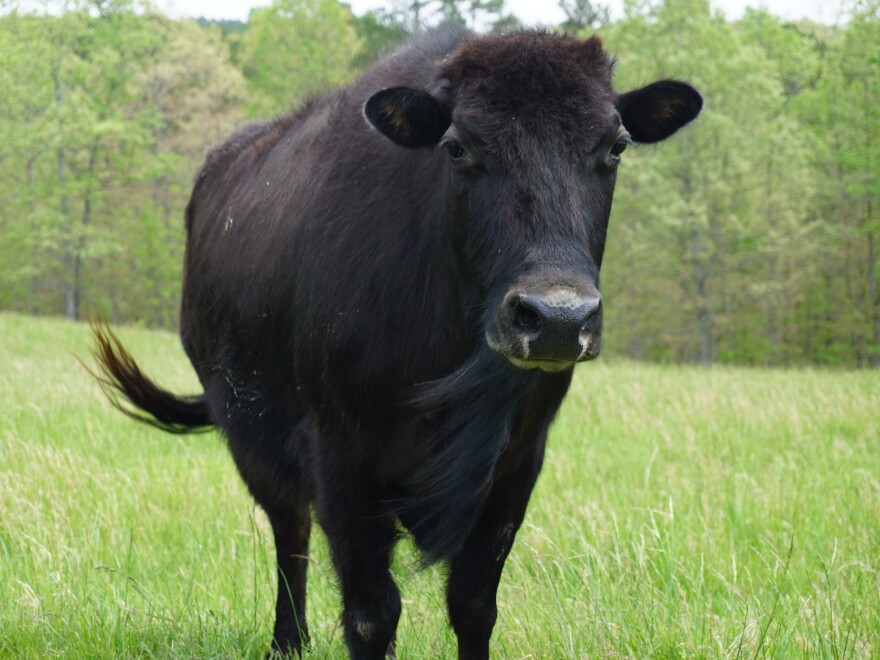With our free press under threat and federal funding for public media gone, your support matters more than ever. Help keep the LAist newsroom strong, become a monthly member or increase your support today.
Beefalo, a bison-cattle hybrid, is being touted as the healthy meat of the future

Bison produce very lean meat, but they are wild animals that can be difficult to raise on a farm. Cattle are very docile, but their meat can be high in fat and not very healthy.
That's why proponents of a crossbreed — called beefalo — say they have what should be the future of U.S. meat production.
"As we like to say, when they created beefalo, they bred out the meanness but kept the leanness of the bison, so kept the good qualities of the bison," said Kelly Dietsch.
She and her husband, Andrew Dietsch, run A&K Ranch in Raymondville, Mo., where they have about 25 beefalo females that they attempt to calve every year.
The bovine is bred to include more cattle traits than bison. The American Beefalo Association says beefalo with 37.5% bison genes are considered full-blood beefalo and the perfect mix for the breed. But bovines with as low as 18% bison genes are labeled purebred beefalo.
While there was some unintentional cross-breeding between cows and bison over the centuries, it wasn't until the 1970s that a reliable, fertile crossbreed was produced. The intent was to get the lean meat of bison into an animal that could be raised as easily as a cow.
The Dietsches have found that to be the case. They used to raise cattle when they lived in New Jersey, but switched to beefalo when they moved to the Midwest.
"I like doing the beefalo because they are a lot easier to work with," Andrew Dietsch said.
But it's the quality of the meat that will bring more ranchers on board, according to John Fowler, an American Beefalo Association board member.
"If I can get a person who has a crossbred herd and put a beefalo bull in his herd and have him eat some of the meat, he's sold. He'll want to produce the beefalo," he said.

Fowler, who also raises beefalo in northern Missouri, calls it a superior animal compared to cattle. The U.S. Department of Agriculture has certified beefalo as having higher vitamin levels and more protein, while having nearly one-third less cholesterol, 79% less fat and 66% fewer calories than conventional beef.
But beefalo does have its opponents.
"We just don't think there should be beefalo," said Martha McFarland, farmland viability coordinator for the advocacy group Practical Farmers of Iowa. She also raises cattle and bison, but said she would never mix the two.
"Nature did just fine producing bison. It's an excellent animal that also is good to eat, and mixing it with cows is not necessary and weakens the genetic line of the bison."
Yet McFarland does empathize with beefalo producers, who are trying to raise, promote and sell a niche meat, just as she does with bison.
"A lot of times it's hard to find that middleman to get my meat into the grocery store. I'm not part of this huge, mechanized system," she said. "My challenge is your average consumer wants to just, like, go to the grocery store and pick up some food and be done with it."
Kelly and Andrew Dietsch sell most of their beefalo at three farmers markets, where they've gained loyal customers who have come to prefer the lean meat. But beefalo isn't in many grocery stores, and it also costs more than beef, largely because it comes from small producers.
Even so, the Dietsches are optimistic about the future of the specialty meat. Andrew Dietsch points to new leadership on the American Beefalo Board, as well as Americans' growing interest in where their food comes from.
"It's competitive, but it's a lot better than it used to be," he said. "They have some new people [on the board] that have a lot of good ideas. They are really reaching out there. They have a Facebook page, and you can find beefalo all over the country."
Jonathan Ahl reports from Missouri for St. Louis Public Radio and Harvest Public Media, a collaboration of public media newsrooms in the Midwest. It reports on food systems, agriculture and rural issues.
Copyright 2022 Harvest Public Media. To see more, visit . 9(MDA1OTI3MjQ5MDEyODUwMTE2MzM1YzNmZA004))







